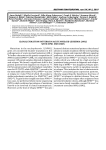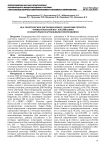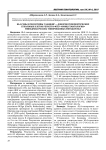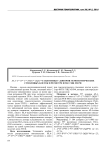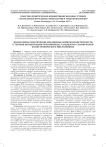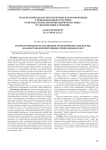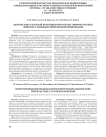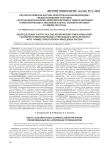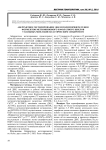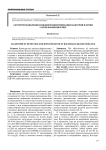Статьи журнала - Вестник гематологии
Все статьи: 666
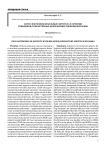
AHTH-CD38 моноклональные антитела в лечениирецидивов/рефрактерных форм множественной миеломы
Статья научная
Использование новых подходовв лечении рецидивов и рефрактерных форммножественной миеломы (ММ) привело к существенному улучшению показателей общейвыживаемости больных, достижению качественного ответа и более длительной ремиссиипо сравнению с пациентами, получавшимистандартную химиотерапию. Представленныйобзор посвящен вопросам терапевтическойэффективности, безопасности и особенностям практического применения анти-CD38 моноклональных антител. Одна из характерных особенностей опухолевых плазматических клеток - высокая экспрессия на их поверхностиCD38. Меньший уровень экспрессии выявляетсяна плазматических клетках здоровых людей,а также на нормальных лимфоидных, миелоидных клетках, других типах клеток и тканейнегемопоэтических органов. CD38 обладаетмножеством функций, включая опосредованную рецепторами адгезию, сигнальную и ферментативную активность. CD38 - трансмембранный гликопротеин, который выполняетроль клеточного рецептора и эктоэнзима, участвующего в накоплении энергии. К настоящему времени предложены три анти-CD38 моноклональных антитела, обладающих сходным механизмом действия,- даратумумаб (полностью человеческое моноклональное антитело),изатуксимаб (химерическое моноклональноеантитело) и MOR202 (полностью человеческое моноклональное антитело). В 2008 годударатумумаб (IgG1-k) был первым моноклональным CD38 антителом, которое назначили больному ММ. Даратумумаб был отобраниз панели 42 антител, способных индуцировать лизис опухолевых клеток c экспрессией CD38 посредством комплементзависимой цитотоксичности. Кроме того, даратумумаб обладает антителозависимой клеточной цитотоксичностью и антителозависимым клеточным фагоцитозом, действуя через активацию Fcyрецепторов иммунных эффекторных клеток.В исследованиях 2 фазы SIRIUS и GEN501 продемонстрирована эффективность даратумумаба в монорежиме при рецидивах/рефрактерных формах ММ, у пациентов, получивших в среднем пять линий предшествующей терапии,при двойной рефрактерности (к иммуномодуляторам и ингибиторам протеасомы). Даратумумаб используется в комбинированнойтерапии с леналидомидом и дексаметазоном.В исследовании 3 фазы POLLUX при дополнении даратумумаба к схеме леналидомид + дексаметазон отмечено существенное увеличение выживаемости без прогрессирования (не достигнута vs. 17,5 мес.; Р function show_abstract() { $('#abstract1').hide(); $('#abstract2').show(); $('#abstract_expand').hide(); }
Бесплатно
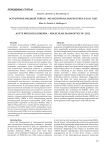
Acute myeloid leukemia – molecular diagnostics in 2021
Статья научная
Acute myeloid leukemia (AML) develops as a clonal expansion of undifferentiated myeloid precursors that have somatically acquired mutations, which account for the biological and clinical complexity of the disease. Over the past decades, there has been a growing knowledge on the pathogenic relevance of these genomic aberrations. Recently, molecular genomic diagnostics have begun to be translated into the clinic, and mechanisms of clonal leukemia evolution and disease dynamics are starting to be understood, especially as novel next generation sequencing (NGS) technologies allow us to capture multiple competing clones coexisting at any disease time point. This review provides a short summary of molecular diagnostics and the impact of genomic changes on the individual patient outcome. Molecular diagnostics forms the basis for novel genomic classification schemes that are reproducible and clinically relevant. In accordance, next to the well-established molecular markers NPM1, CEBPA, and FLT3, the updated version of the European LeukemiaNet (ELN) guidelines also recommends the screening for RUNX1, TP53, and ASXL1 mutations. In the future, these as well as other AML associated aberrations will not only be crucial in determining measurable residual disease (MRD), but also in guiding targeted therapeutic approaches and novel genome-wide approaches will lead the way.
Бесплатно
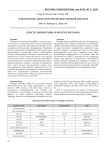
Genetic aberrations in multipe myeloma
Статья научная
Multiple myeloma (MM) is a plasma cell malignancy characterized by complex cytogenetic and molecular genetic aberrations. Genomic analysis shows a variety of gene mutations, aneuploidies, segmental copynumber changes, translocations that are extremely heterogeneous, and more numerous than other hematological malignancies. It is known that the development of MM is preceded by pre-malignant stages, and therefore it represents a well-defined model of disease progression, suitable for studies of clonal evolution and heterogeneity. Here we review at the main genetic abnormalities in patients with MM, involvement in pathogenesis, and prognostic value
Бесплатно
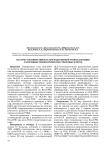
HLA-DPB1-несовместимость при родственной трансплантации аллогенных гемопоэтических стволовых клеток
Статья
Бесплатно
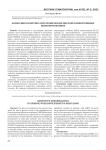
Karyotype abnormalities in chronic myeloproliferative neoplasms
Статья обзорная
The data accumulated by the present time about the role of genetic events in the pathogenesis of chronic myeloproliferative neoplasms (CMPN) have made it possible to develop new approaches to the diagnosis and treatment of these diseases. Despite the widespread introduction of molecular methods into the medical practice, classical cytogenetic research continues to hold one of the main positions in the diagnosis and monitoring of CMPN. Cytogenetic examination allows to evaluate the entire karyotype without reference to molecular loci and to identify marker, recurrent and unique chromosomal abnormalities having diagnostic and prognostic value. Numerical and structural abnormalities of chromosomes are detected in the karyotype of leukemic clones in a significant number of patients with CMPN, herewith the proportion of patients with an altered karyotype, as well as the spectrum of cytogenetic disorders increases with the progression of the disease. The review article examines literature data concerning the main points of the pathogenesis of CMPN and the role of a wide profile of clonal cytogenetic anomalies that can be detected in the karyotype of the patient leukemia cells.
Бесплатно
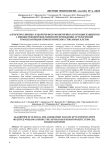
Статья научная
Значительные успехи в лечении множественной миеломы (ММ), отмеченные в последние годы, являются результатом влияния ряда факторов. Среди них можно выделить: использование в широкой клинической практике многокомпонентных схем терапии, с включением препаратов таргетного действия; проведение аутологичной трансплантации гемопоэтических стволовых клеток (аутоТГСК), в качестве стандартной консолидирующей терапевтической опции для кандидатов на высокодозную химиотерапию; назначение поддерживающей терапии, интенсивность и длительность которой варьируют в зависимости от биологического фенотипа заболевания и объема остаточной болезни. Вместе с тем, ММ остается неизлечимым заболеванием. При выборе терапевтической опции клиницисты руководствуются необходимостью достижения целей: 1) устойчивый негативный статус минимальной остаточной болезни (МОБ), обуславливающий бо́льшую вероятность устойчивого ответа, более длительные выживаемость без прогрессии (ВБП) и общая выживаемость (ОВ); 2) оптимальное для конкретного пациента качество жизни (КЖ) с последующим сохранением его в течение максимально возможного периода времени. Эффективность каждого этапа терапии ММ является существенным условием достижения приемлемого ответа на лечение. Так, эффективность аутоТГСК является интегральным показателем, который учитывает следующие факторы: вариант ответа на предшествующую терапию; интенсивность режима кондиционирования и оптимальное количество перелитых CD34+ гемопоэтических стволовых клеток (ГСК), осложнения аутоТГСК. На эффективность аутоТГСК может оказывать влияние ряд дополнительных факторов: характеристики продукта афереза ГСК (трансплантата), влияние микробиоты кишечника и динамики ее изменений на фоне лечения, генетический профиль ММ. Успешное проведение аутоТГСК способствует своевременному переходу к следующему этапу комплексной терапии ММ. Целью работы явилась разработка алгоритма клинико-лабораторного мониторинга пациентов с ММ при проведении аутоТГСК, с изучением факторов, оказывающих влияние на эффективность данного этапа терапии.
Бесплатно


